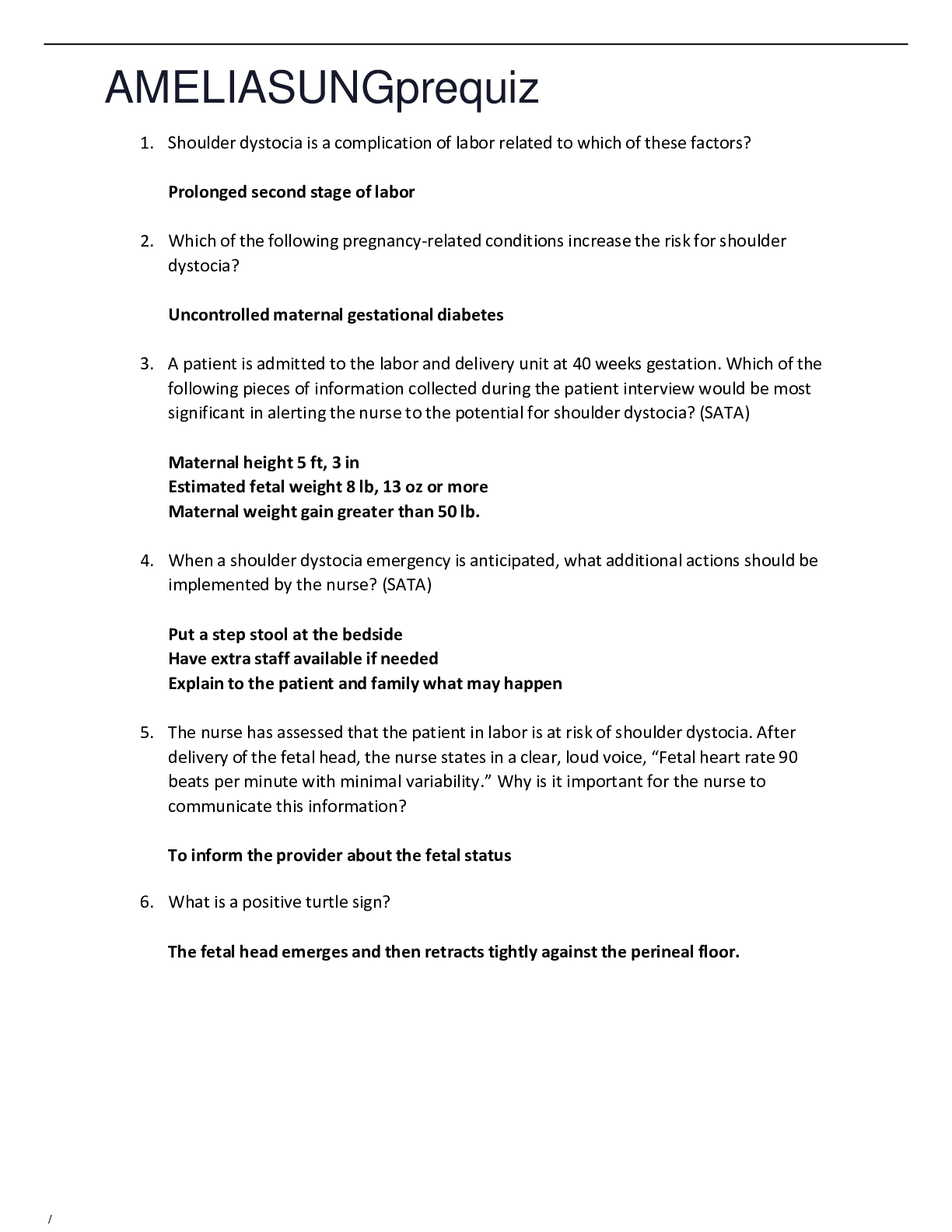Test Bank Economics 11th Edition,2021 LATEST GRADED A.
Document Content and Description Below
1) The answers to an economy's three central economic problems are determined by the interaction of three forces: economic forces, political forces, and social forces. 2) Scarcity exists becau... se economies cannot produce enough to meet the perceived desires of all individuals. 3) Only marginal costs, not sunk costs, affect economic decisions if individuals are rational. 4) The economic decision rule is to undertake an action only when the marginal benefits of that action are greater than its total costs. 5) The opportunity cost of undertaking an activity includes any sunk cost. 6) The "invisible hand" is the price mechanism that guides people's actions in the market. 7) Social and political forces affect the way in which the invisible hand works. 8) Macroeconomics is the study of how individual choices are affected by economic forces. 9) Deciding what the distribution of income should be is an example of normative economics. 10) Say a pill existed that made people selfless. After taking it they were only interested in others, not themselves. Under the coordination definition of economics: A) no economic problem would exist. B) there still would be an economic problem. C) there would be a political problem but not an economic problem. D) there would be a social problem but not an economic problem. 11) According to the text, economics is the study of how: A) governments allocate resources in the face of constraints. B) government policies can be used to meet individuals' wants and desires. C) human beings coordinate their wants and desires. D) scarce resources are allocated between capitalists and workers. 12) Dorm rooms usually are not allocated by markets. Allocating dorm rooms is: A) not an economic problem. B) an economic problem. C) not affected by economic forces. D) determined by prices. 13) If allocating dorm rooms changes from allocation by lottery to allocation by the market: A) it becomes an economic problem. B) it becomes a political problem but not an economic problem. C) it becomes a social problem but not an economic problem. D) the allocation problem is still an economic problem. 14) Which of the following is not one of the three central coordination problems of the economy given in the book? A) What B) Whether C) For whom D) How 15) The quantity of goods and services available to society: A) is fixed. B) depends on human action. C) is not of economic importance. D) will always grow to meet individuals' wants and desires. 16) Economic systems: A) can eliminate scarcity. B) address the questions what is produced, how it is produced, and for whom it is produced. C) provide all the goods people want and desire. D) provide equal distribution of well-being among its participants. 17) Scarcity exists because: A) individuals cannot solve the three central coordination problems. B) governments cannot solve the three central coordination problems. C) the supply of goods is always less than the demand. D) new wants continue to develop and willingness to meet them is limited. 18) People can reasonably expect that an economic system will decide all of the following except: A) what goods to produce. B) how to produce the goods. C) how to assign initial property rights. D) for whom to produce the goods. 19) To engage in economic reasoning, one must compare: A) total cost and total benefit. B) marginal cost, sunk cost, and total benefit. C) sunk cost and marginal cost. D) marginal cost and marginal benefit. 20) Alexandra has determined that studying an hour for her economics quiz will improve her grade on the quiz from a 75 to a 100. She also determines that this improvement is worth $20. To study for an hour for her economics quiz, however, she will have to work one fewer hour at her part-time job. Alexandra should: A) study for the quiz as long as her hourly wage rate is less than $20. B) study for the quiz as long as her hourly wage rate is more than $20. C) study for the quiz only if her hourly wage rate is exactly $20. D) not study for the quiz because earning a higher grade cannot have a dollar value. 21) Microsoft filed a lawsuit against people who sent spam (junk email) and a website owner who hosted spam services. A spokesman for Microsoft said that Microsoft was "trying to change the economics of spam" by increasing the cost of being a spammer. An economist most likely would agree with which statement about Microsoft's actions? A) A more effective approach would be to educate spammers about the costs they impose on others. B) A more effective approach would be to appeal to the morals of the spammers and tell them to follow the Golden Rule. C) Microsoft's approach of trying to change the costs of spamming is the most efficient way to change behavior. D) Microsoft should not be involved because spamming is just part of the invisible hand at work and should be left alone. 22) The marginal benefit from consuming another unit of a good: A) must equal the marginal cost or the unit will not be consumed. B) must be less than the marginal cost or the unit will not be consumed. C) equals the increase in total benefits from consuming the unit. D) equals the total benefit obtained from the consumption of all prior units. 23) The marginal cost of consuming another unit of a good: A) must equal the marginal benefit or the unit will not be consumed. B) must exceed the marginal benefit or the unit will not be consumed. C) equals the increase in total cost when another unit is consumed. D) equals the total cost of consuming all prior units. 24) Mary buys cell-phone services from a company that charges $30 per month. For that $30 she is allowed 600 minutes of free calls and then pays 25 cents per minute for any calls above 600 minutes. Mary has used 300 minutes this month so far. What is her marginal cost per minute of making two more calls lasting 10 minutes each? A) $2.50 B) 25 cents C) 4 cents D) $0 25) Mary buys cell-phone services from a company that charges $30 per month. For that $30 she is allowed 600 minutes of free calls and then pays 10 cents per minute for any calls above 600 minutes. Mary has used 600 minutes this month so far. What is her marginal cost per minute of making additional calls? A) 25 cents B) 10 cents C) 5 cents D) $0 26) Sunk costs: A) are an essential part of economic decision making. B) are irrelevant to economic decision making. C) should be considered, but only when marginal cost is less than marginal benefit. D) should be considered only when there is no information about marginal cost and marginal benefit. 27) Suppose the marginal cost of dating Perry is $30 and the marginal benefit is worth $40 to you. Following economic reasoning, you should: A) date Perry. B) not date Perry. C) determine what your sunk costs are. D) determine what your total benefits and total costs are. 28) The table below shows how the marginal benefit of car washes varies for Carol with the number purchased per month. Car washes per month Marginal benefit of purchasing an additional car wash 1 $6.00 2 $5.00 3 $4.00 4 $3.00 5 $2.00 The price of each car wash is reduced from $2.99 to $1.99. Assuming that the price of a car wash accurately reflects the marginal cost to Carol and that she is rational, she will increase the number of car washes purchased per month from: A) one to two. B) two to three. C) three to four. D) four to five. 29) The table below shows how the marginal benefit of pizza dinners varies for Luigi with the number consumed per month. Dinners per month Marginal benefit per dinner 1 $4.00 2 $3.00 3 $2.00 4 $1.00 Suppose the price per dinner is $4.99 and accurately reflects the marginal cost of the dinners to Luigi. Assuming that Luigi is rational, he will: A) not consume any pizza dinners this month. B) consume one pizza dinner this month. C) consume two pizza dinners this month. D) consume three pizza dinners this month. 30) The price of a new model of iPad tends to fall significantly a year after it is introduced. Suppose Jane bought an iPad as soon as it was introduced (a year ago) and paid a premium price for it. Now she wants to buy an iPad cover. Which of the following should she consider before buying the new accessory? A) The price she paid for her iPad, the price of the iPad cover, and the benefit she'll receive from using the iPad cover B) The price of replacing her iPad, the price of the iPad cover, and the benefit she'll receive from using the iPad cover C) The price of the iPad cover and the benefit she'll receive from using the iPad cover D) The price of the iPad cover had she bought it with the iPad, the current price of the iPad cover, and the benefit she'll receive from using the iPad cover 31) You bought one share of McDonald's stock for $10, one share of Coca-Cola for $15, and one share of Pepto-Bismol for $20. Currently, each stock is priced at $15. Assuming that there are no tax issues and that you cannot predict the future price of any of the stocks, if you needed $15, which stock would you sell? A) McDonald's B) Coca-Cola C) Pepto-Bismol D) Any one of them 32) Which of the following best defines rational behavior? A) Analyzing the total gains from a decision B) Improving net gain by pursuing decisions as long as the marginal benefits exceed the marginal costs C) Seeking to gain by choosing to undertake actions as long as the marginal costs exceed the associated marginal benefits D) Seeking to maximize total gain regardless of cost 33) Alan is sitting in a bar drinking beers that cost $4 each. According to the economic decision rule, Alan will stop drinking when the marginal: A) benefit to him of an additional beer is less than $4. B) cost to him of an additional beer is less than the marginal benefit. C) cost remains at $4. D) benefit to him of an additional beer is greater than $4. 34) Chuck offers $240,000 for a house. The seller turns down the offer but says she will sell the house for $260,000. However, Chuck refuses to pay the higher price. If Chuck is following the economic decision rule, the marginal benefit of the house to: A) Chuck must be less than $260,000. B) Chuck must be greater than $260,000. C) The seller must be less than $260,000. D) The seller must be less than $240,000. 35) The marginal benefit of another T-shirt this month to Mary is $15. If the $10 price of a T-shirt reflects its marginal cost to Mary and Mary uses economic reasoning, she: A) will sell the T-shirts she has to others who are willing to pay $10. B) will not gain anything by buying another T-shirt. C) will buy another T-shirt this month. D) will not buy a T-shirt this month. 36) The marginal benefit of you going to a movie during the week is currently $6. Assume that the $4 price of going to the movies measures its marginal cost. Following the economic decision rule, you will: A) continue going to movies until the marginal benefit of doing so falls to zero. B) choose not to go to any movies during the week. C) continue going to movies until the marginal benefit of doing so falls below $4. D) not be able to enjoy a net gain from going to the movies during the week. 37) Marginal analysis suggests that you will engage in more of an activity if the: A) total benefit of the activity is less than the total cost. B) additional benefit from the activity exceeds the additional cost. C) total benefit from the activity exceeds the total cost. D) additional cost of the activity exceeds the additional benefit. 38) You've purchased a car for $20,000 and now are deciding whether to have a sunroof installed for $800 and a security system installed for $200. The marginal cost of adding both the sunroof and the security system is: A) $21,200. B) $20,000. C) $800. D) $1,000. 39) You're deciding whether to install an $800 moonroof and a $400 security system in your car. Suppose the marginal benefit from the moonroof is $700 and the marginal benefit from the security system is $600. The economic decision rule dictates that you should: A) purchase only the moonroof because that will provide you with the greatest marginal benefit. B) purchase only the security system because its marginal benefit exceeds its marginal cost. C) purchase both options because the combined cost of both is less than the combined benefit. D) not purchase either because the benefits of each do not exceed the costs. 40) Your opportunity cost of taking this course is the: A) tuition you paid for the course. B) net benefit of the activity you would have chosen if you had not taken the course. C) net benefit of taking this course. D) cost of the activity you would have chosen if you had not taken the course. 41) Economic reasoning would argue that there is an opportunity cost to: A) all choices. B) more choices. C) only choices that involve money. D) only choices that do not involve money. 42) Suppose you paid $300 to take this economics course, which meets 30 times for one hour a class during the course of the semester. Instead of attending class you could have either flipped hamburgers for $10 an hour or waited tables for $8 an hour. Given this information, the opportunity cost of attending each class session is: A) $30. B) $10. C) $8. D) $13. 43) Opportunity cost: A) includes only monetary expenses. B) is the net benefit forgone by not undertaking the next best alternative. C) is nonexistent for some choices. D) is the same as sunk cost. 44) Based on scientific nutritional studies, in most countries an income of $1 a day does not provide sufficient food, shelter, and clothing to live. Under these conditions the medical risk of death is high. This statement is: A) a normative statement. B) a subjective statement. C) an art-of-economics statement. D) a positive statement. 45) The opportunity cost of attending college for one year is best measured by the: A) benefit received by the student. B) tuition paid for the year. C) value of the next-best activity forgone by attending college. D) total money expenses associated with attending college. 46) Brooke and Sandy both attend the same college and have the same expenses for tuition, books, and supplies. However, Brooke is a famous actress who could earn $2 million per year if she were not attending college whereas Sandy could earn $10,000 a year serving hamburgers if he were not attending college. It follows that the opportunity cost of attending college: A) is the same for both Brooke and Sandy. B) is greater for Brooke than for Sandy. C) is greater for Sandy than for Brooke. D) for Brooke and Sandy cannot be compared. 47) When your wages rise, the: A) opportunity cost of an hour of work decreases. B) opportunity cost of an hour of leisure stays the same. C) cost of working increases. D) opportunity cost of an hour of leisure increases. 48) If it takes you an hour to make a rational decision and the opportunity cost of that hour is $100, you will: A) always make rational decisions. B) make rational decisions only if the benefit from doing so exceeds $100. C) make rational decisions only if the benefit from doing so is less than $100. D) never make rational decisions. 49) Applying the concept of opportunity cost to the pollution of a lake, an economist probably would conclude that: A) all pollution in the lake should be eliminated regardless of cost. B) no pollution in the lake should be eliminated regardless of benefit. C) pollution should be eliminated as long as the benefit from a cleanup exceeds the opportunity cost. D) pollution should be eliminated as long as the opportunity cost of a cleanup exceeds the cost of the resources required for the cleanup. 50) For a given benefit, a rational person chooses the option that has: A) the lowest opportunity cost. B) the highest opportunity cost. C) the average opportunity cost. D) no opportunity cost. 51) More than 10,000 visitors waited up to two hours in line to see the rare flower titan arum at the Cambridge Botanical Gardens. What does this situation illustrate to an economist about rationing? A) Goods don't have to be rationed by lottery or first-come, first-served. Goods can be rationed by price. B) When goods are not fully rationed by monetary price, other rationing mechanisms such as waiting arise. C) When goods are not rationed by monetary price, other rationing mechanisms such as lottery must be introduced. D) There is no need for rationing if anyone who waits long enough can see the flower. 52) Dogfighting is against the law in New Jersey, resulting in high-priced events held illegally in the state. What idea from Chapter 1 of the text does this story best illustrate? A) There ain't no such thing as a free lunch. B) The invisible hand is always invisible. C) Social and political forces sometimes rein in market forces. D) Maintaining objectivity is easiest in positive economics. 53) Prostitution is legal in Churchill County, Nevada, but a referendum threatened to close two brothels (prostitution businesses) in that county. What idea from Chapter 1 of the text does this story best illustrate? A) Sunk costs do not matter in making decisions. B) Marginal revenue should equal marginal cost C) Social and political forces sometimes rein in market forces. D) Microeconomics and macroeconomics are very much interrelated. 54) Nepalese villagers sell their kidneys as a way to earn much-needed money. Unfortunately, although the demand for such kidneys in developed economies is high and the medical facilities are available to conduct kidney transplants, the selling and buying of organs is illegal. What idea from Chapter 1 of the text does this situation best illustrate? A) Sunk costs do not matter in making decisions. B) Marginal revenue should equal marginal cost. C) Social and political forces sometimes rein in market forces. D) Microeconomics and macroeconomics are very much interrelated. 55) Countries such as Brazil, India, and Moldova—well-known sources of organ donors—have banned buying and selling organs. This legal action comes at the risk of driving the trade underground. What idea from Chapter 1 of the text does this story best illustrate? A) Legal and social forces can eliminate economic forces. B) Marginal revenue should equal marginal cost. C) Economic forces always operate despite legal forces. D) The invisible hand is not always invisible. 56) Economic forces: A) are a reaction to scarcity. B) give rise to scarcity. C) are not related to scarcity. D) are not related to rationing. 57) An economic force given relatively free rein by society to work through the market is a: A) market force. B) social force. C) price mechanism. D) political force. 58) The price mechanism that guides people's actions is called the: A) invisible market force. B) invisible hand. C) invisible handshake. D) invisible foot. 59) Antitrust laws are an example of: A) social forces. B) political forces. C) economic forces. D) the invisible hand. 60) Microsoft has just taken some senators out to dinner in Paris in a private jet. This is probably an example of an attempt to influence: A) economic forces. B) political forces. C) social forces. D) the price mechanism. 61) The price of computers has fallen each year for the last 30 years. This is probably an example of the working of: A) economic forces. B) political forces. C) social forces. D) nonmarket forces. 62) A cultural norm is a(n): A) economic force. B) social force. C) political force. D) market force. 63) The price mechanism is: A) not affected by social and political forces. B) affected by social but not political forces. C) affected by political but not social forces. D) affected by both political and social forces. 64) Political forces: A) affect the price mechanism through cultural norms. B) affect the price mechanism through the legal system. C) affect the price mechanism through scarcity. D) do not affect the price mechanism. 65) Social forces: A) affect the price mechanism through cultural norms. B) affect the price mechanism but not the legal system. C) affect the price mechanism through scarcity. D) do not affect the price mechanism. 66) Even though 80,000 individuals in the United States wait for kidney transplants and, for a price, there are many individuals who would be willing to supply a kidney (a healthy person can donate one kidney without any problems), it remains illegal to buy and sell organs in the United States. A market for kidneys does not exist because of: A) political forces. B) social forces. C) economic forces. D) market forces. 67) Many drugs are illegal in the United States. Despite this law, illegal drugs are usually available at a price many times higher than they would be if the drugs weren't illegal. The high price of illegal drugs is an example of: A) the market affecting political forces. B) political forces affecting the market. C) the failure of the market. D) the failure of political forces. 68) The fact that the price of a gallon of milk is likely to be more expensive at a convenience store than at a supermarket is an example of: A) market forces. B) political forces. C) social forces. D) normative economics. 69) Economic forces: A) are more powerful than social and political forces. B) are more powerful than social forces but less powerful than political forces. C) are less powerful than social and political forces. D) can be more or less powerful than political and social forces depending on the circumstances. 70) An economic model: A) applies economic theory to understand real-world events. B) is so abstract that it cannot be applied to real-world events. C) can be used only to understand free markets. D) is an action taken to influence the course of economic events. 71) An economic principle: A) should be used to make every individual decision. B) generally is stated as a normative statement. C) can be combined with knowledge of economic institutions to make policy proposals. D) is an action taken to influence the course of economic events. 72) Economics is primarily: A) a normative science. B) an observational science. C) a laboratory science. D) a natural science. 73) Experimental economics: A) includes naturally occurring events that approximates a controlled experiment. B) is not possible given that economists study real-world events. C) creates its own data rather than using data from the real world. D) is what all economists do when they develop their models. 74) An economist secures volunteers from her college campus and divides them into two groups that are ushered into different rooms. Both groups are given a test. Those in the first group who score 90 percent or more receive an Apple iPad. Upon exiting the room, those given iPads are offered the choice of receiving $150 in exchange for the iPad. Only a few take the exchange. Those in the second group who score 90 percent are offered either an Apple iPad or $150. About half the students choose $150. The professor uses this data to support a principle known as the endowment effect. The professor is engaging in: A) experimental economics. B) natural experiments. C) the economic decision rule. D) a market coordination mechanism. 75) A natural experiment is: A) a naturally occurring event that approximates a controlled experiment. B) not possible given that economists study real-world events. C) a branch of economics that studies the economy through controlled lab experiments. D) what all economists do when they develop their models. 76) New Jersey raises its minimum wage while neighboring state Pennsylvania, does not. Economists compared the labor market in both states to draw conclusions about the effect of a minimum wage on employment and wages. This is an example of: A) simulation economics. B) a natural experiment. C) an economic principle. D) the economic decision rule. 77) A theorem is: A) the application of models combined with judgment. B) a policy rule that concludes that a particular course of action is preferable. C) a proposition that is logically true based on the assumptions of a model. D) a set of equations that define a model. 78) Propositions that are logically true based on the assumptions of a model are known as: A) precepts. B) theorems. C) insights. D) policies. 79) A precept is: A) the application of models combined with judgment. B) a policy rule that concludes that a particular course of action is preferable. C) a proposition that is logically true based on the assumptions of a model. D) a set of equations that define a model. 80) A policy rule that concludes that a particular course of action is preferable is known as a(n): A) precept. B) theorem. C) insight. D) policy. 81) The statement, "because the invisible hand allocates resources efficiently, economies ought to minimize government interference" is an example of: A) an economic theorem. B) an economic precept. C) a natural experiment. D) efficiency. 82) Which statement best summarizes the invisible hand theorem? A) Government policies direct people's selfish desires (tempered by social and economic forces) to the benefit of society. B) Cultural norms direct people's selfish desires (tempered by political and economic forces) to the common good. C) Markets direct people's selfish desires (tempered by political and social forces) to the common good. D) Social, political, and economic forces act against people's selfish desires to promote the common good. 83) A necessary assumption behind the invisible hand theorem is that: A) market forces are determined by cultural norms. B) market forces produce inefficient outcomes. C) the price mechanism is not constrained by political or social forces. D) people behave rationally. 84) An economist who is studying the relationship between the money supply, interest rates, and the rate of inflation is engaged in: A) microeconomic research. B) macroeconomic research. C) theoretical research because there is no data on these variables. D) empirical research because there is no economic theory related to these variables. 85) The invisible hand theorem comes from: A) microeconomics. B) macroeconomics. C) sociology. D) political science. 86) Microeconomics and macroeconomics are: A) not related because they are taught as separate courses. B) virtually identical, though one is much more difficult than the other. C) interrelated because what happens in the economy as a whole is based on individual decisions. D) interrelated because both are taught by the same teacher. 87) Which of the following is least likely to be studied in macroeconomics? A) Inflation B) Unemployment C) Business cycles D) Advertising 88) Macroeconomics is: A) the study of individual choice and how that choice is influenced by economic forces. B) the study of the pricing policies of firms and the purchasing decisions of households. C) the study of aggregate economic relationships. D) an analysis of economic reality that proceeds from the parts to the whole. 89) Which of the following topics is best categorized as a macroeconomic issue? A) The choices a student makes in selecting college courses B) The decision by Apple to produce fewer Macintosh computers C) The effect of a drought on the price of corn D) The effect of an increase in federal spending on the unemployment rate 90) Who would probably argue that you need to study the forest before you can understand the trees? A) A microeconomist B) A macroeconomist C) A normative economist D) A classical economist 91) Who probably would argue that you need to study the trees before you can understand the forest? A) A microeconomist B) A macroeconomist C) A positive economist D) A Keynesian economist 92) Microeconomics includes the study of: A) inflation. B) unemployment. C) business cycles. D) a firm's pricing policies. 93) Macroeconomics includes the study of: A) inflation. B) firm pricing policies. C) the relative prices of oil and coal. D) individual choice. 94) The invisible hand theorem relates mostly to: A) microeconomics. B) macroeconomics. C) normative economics. D) supra-economics. 95) The study of individual choice is a focus in: A) microeconomics. B) macroeconomics. C) normative economics. D) Ricardian economics. 96) The study of inflation is a topic in: A) microeconomics. B) macroeconomics. C) classical economics. D) normative economics. 97) A basic difference between microeconomics and macroeconomics is that: A) microeconomics focuses on the choices of individual consumers, whereas macroeconomics considers the behavior of large businesses. B) microeconomics focuses on financial reporting by individuals, whereas macroeconomics focuses on financial reporting by large firms. C) microeconomics examines the choices made by individual participants in an economy, whereas macroeconomics considers the economy's overall performance. D) microeconomics focuses on national markets, whereas macroeconomics concentrates on international markets. 98) Which of the following topics is most appropriately studied in a microeconomics course? A) The decision by a nurse to change professions B) When the next recession will arrive C) Why unemployment is so low and inflation has not accelerated D) How the presidential candidates' tax plans might affect economic growth 99) Which of the following is not an economic institution? A) Corporations B) Government C) Cultural norms D) None of the answers is correct. 100) An economic policy is: A) a generalization about the workings of an abstract economy. B) a physical or mental structure that significantly influences economic decisions. C) an action taken by the government to influence the course of economic events. D) a standard people use when they determine whether a particular activity or behavior is acceptable. 101) Positive economics seeks to: A) determine the most appropriate economic goals for society. B) determine what government economic policies are best. C) objectively explain how the economy functions. D) objectively explain how societies value different economic outcomes. 102) Normative economics seeks to: A) determine the most appropriate economic goals for a society. B) determine how government policies affect the economy. C) objectively explain how the economy functions. D) objectively explain economic problems such as inflation and unemployment. 103) The statement "government should provide affordable health care coverage for every member of society" is: A) a statement that everyone agrees with. B) a statement that everyone disagrees with. C) a positive statement. D) a normative statement. 104) Say that an economic model concludes that "government raising payroll taxes is a measure that can maintain current Social Security benefit levels for every retiree." This conclusion is: A) a normative statement because there is disagreement over whether Social Security benefits should be maintained. B) a positive statement because raising payroll taxes is one way to maintain Social Security benefits. C) a statement in the art of economics because it is about policy. D) false because there is no payroll tax rate high enough to maintain current benefits. 105) Which of the following statements about urban sprawl and traffic congestion is the best illustration of a normative statement? A) Snarled traffic cost motorists in the 85 largest U.S. cities 3.5 billion hours. B) The average U.S. urban traveler is stuck in road traffic 46 hours a year. C) Traffic congestion has increased in the last 20 years. D) Because urban sprawl is the result of individual choice, it is okay. 106) Which of the following is the best example of a positive question? A) How should the government deal with the next recession? B) Should the government reduce inflation? C) How are price and quantity demanded related? D) Should government allow two large companies to merge? 107) Positive economics is: A) subjective. B) neither objective nor subjective. C) more objective than normative economics. D) more subjective than normative economics. 108) Value judgments in economics: A) are necessary when objective analysis cannot address a question. B) can always be avoided with the use of objective analysis. C) are essential parts of positive economics. D) can be avoided through the use of normative economics. 109) Which of the following tools did Adam Smith argue provided a reasonable way to address normative questions objectively? A) The impartial spectator tool B) The invisible observer tool C) The scientific observer tool D) The reasoned spectator tool 110) Using the impartial spectator tool, one arrives at normative judgments based on your estimation of: A) your own normative judgments. B) the best science available. C) what the blended judgment of all members of society would arrive at. D) the goals of those individuals most harmed by the policy being considered. 111) Someone using the reasoning process consistent with the impartial spectator tool would argue that the minimum wage is a: A) bad policy since, based on one's reasoned judgment, it will cause unemployment. B) good policy since based on one's reasoned judgment, it will raise one's wage. C) bad policy because, based on one's reasoned judgment, it interferes with the market. D) good policy because, based on one's reasoned judgment, it would lead to the greatest good for the greatest number. 112) The art of economics is: A) the application of the knowledge gained by positive economics to the goals set in normative economics. B) purely technical and therefore more objective than positive or normative economics. C) purely subjective so that the economist does not have to strive for the same level of objectivity that positive or normative economists do. D) the branch of economics farthest removed from practical application, since its goal is to create the most elegant mathematical models. 113) "We should support the market because it is efficient" is an example of: A) positive economics. B) normative economics. C) objective economics. D) negative economics. 114) "The distribution of income should be left to the market" is an example of: A) positive economics. B) normative economics. C) the art of economics. D) negative economics. 115) What relates positive economics to normative economics? A) Microeconomics B) Macroeconomics C) The art of economics D) The science of economics 116) "Price controls in competitive markets cause shortages" is an example of: A) positive economics. B) normative economics. C) the art of economics. D) Keynesian economics. 117) "Government should not use price controls" is an example of: A) positive economics. B) normative economics. C) the art of economics. D) Marshallian economics. 118) Maintaining objectivity is easiest in: A) positive economics. B) the art of economics. C) normative economics. D) subjective economics. 119) Identifying the effect of an increase in the money supply on prices requires the use of: A) positive economics. B) the art of economics. C) normative economics. D) subjective economics. 120) Which of the following is a normative statement? A) Reducing the budget deficit will also reduce the balance of trade deficit. B) Tariffs on imported cars result in higher prices for domestic auto consumers. C) A tax cut will cause higher inflation. D) The government should spend more to help the poor. 121) Which of the following is the best example of a normative question? A) How does the market for corn work? B) How do prices affect the market for coffee? C) Will increasing the money supply affect interest rates? D) Will the redistribution of income make society better off? [Show More]
Last updated: 1 year ago
Preview 1 out of 94 pages

Buy this document to get the full access instantly
Instant Download Access after purchase
Add to cartInstant download
We Accept:

Reviews( 0 )
$27.00
Document information
Connected school, study & course
About the document
Uploaded On
May 04, 2021
Number of pages
94
Written in
Additional information
This document has been written for:
Uploaded
May 04, 2021
Downloads
0
Views
39

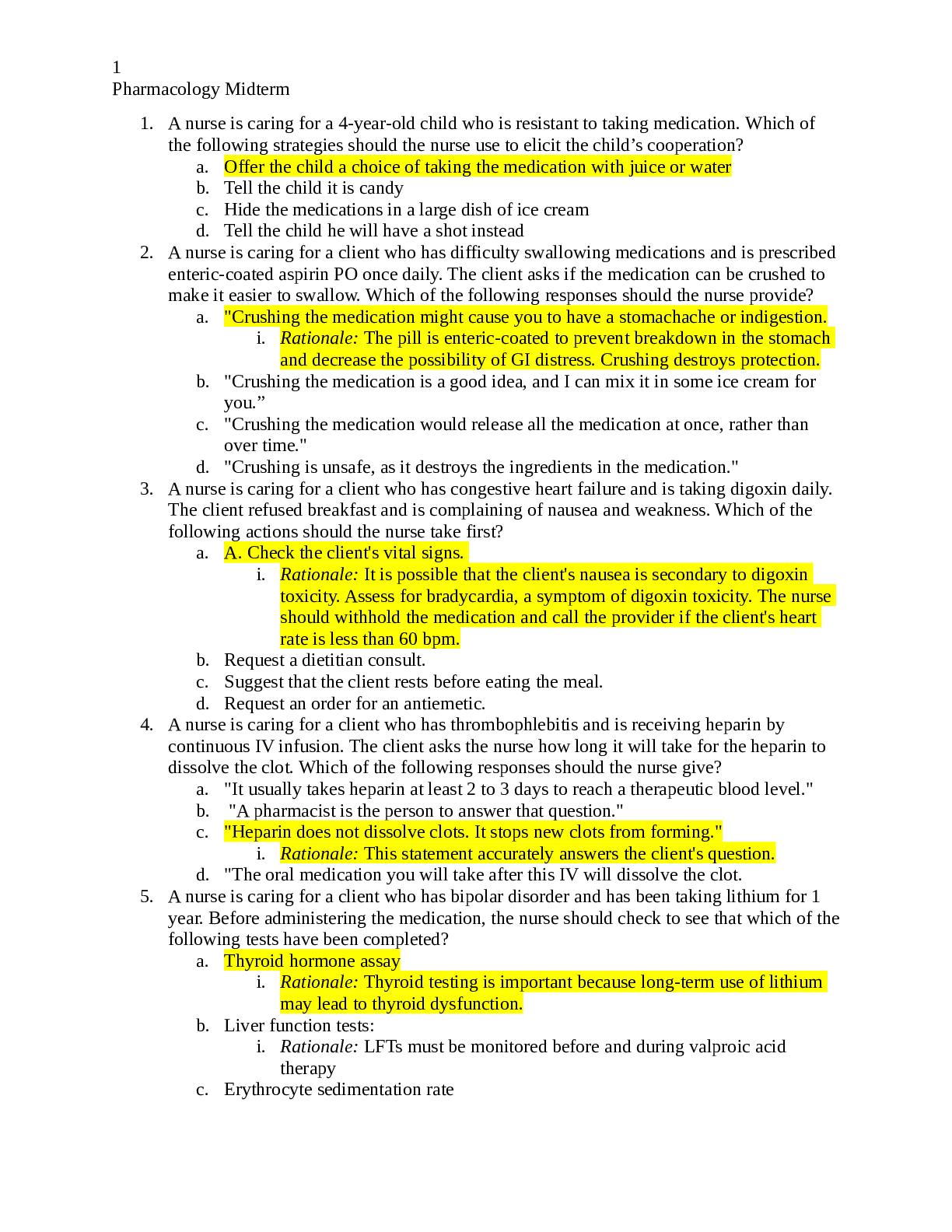
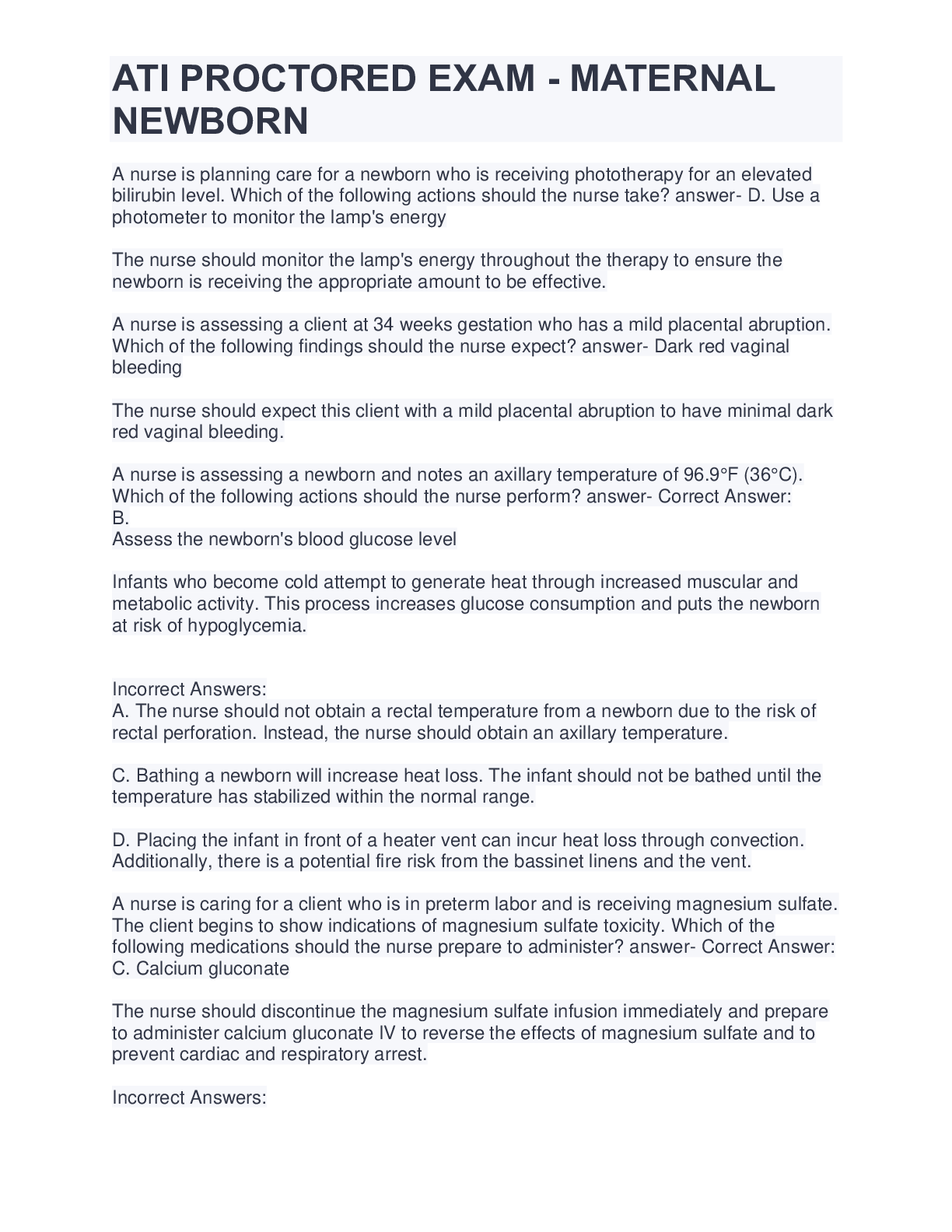

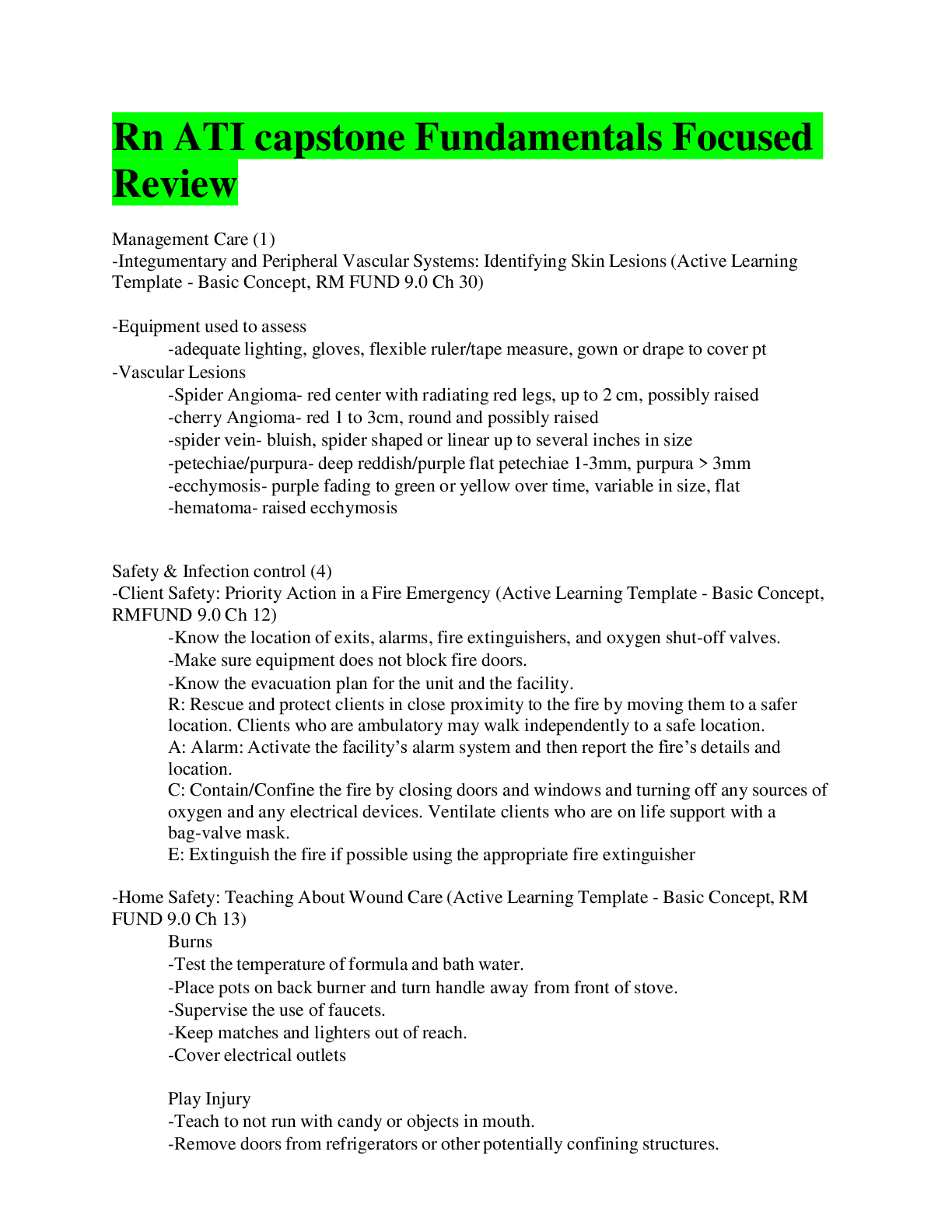
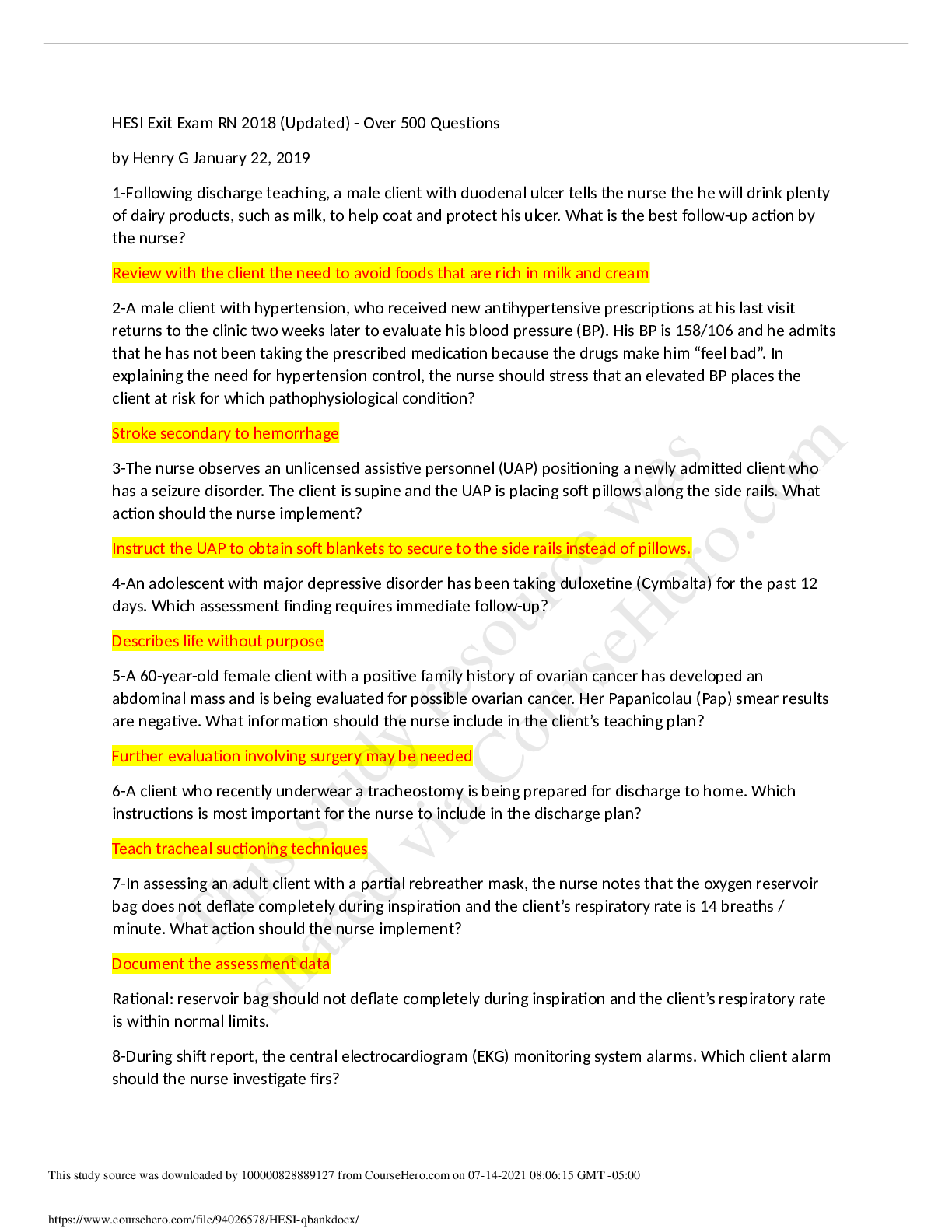

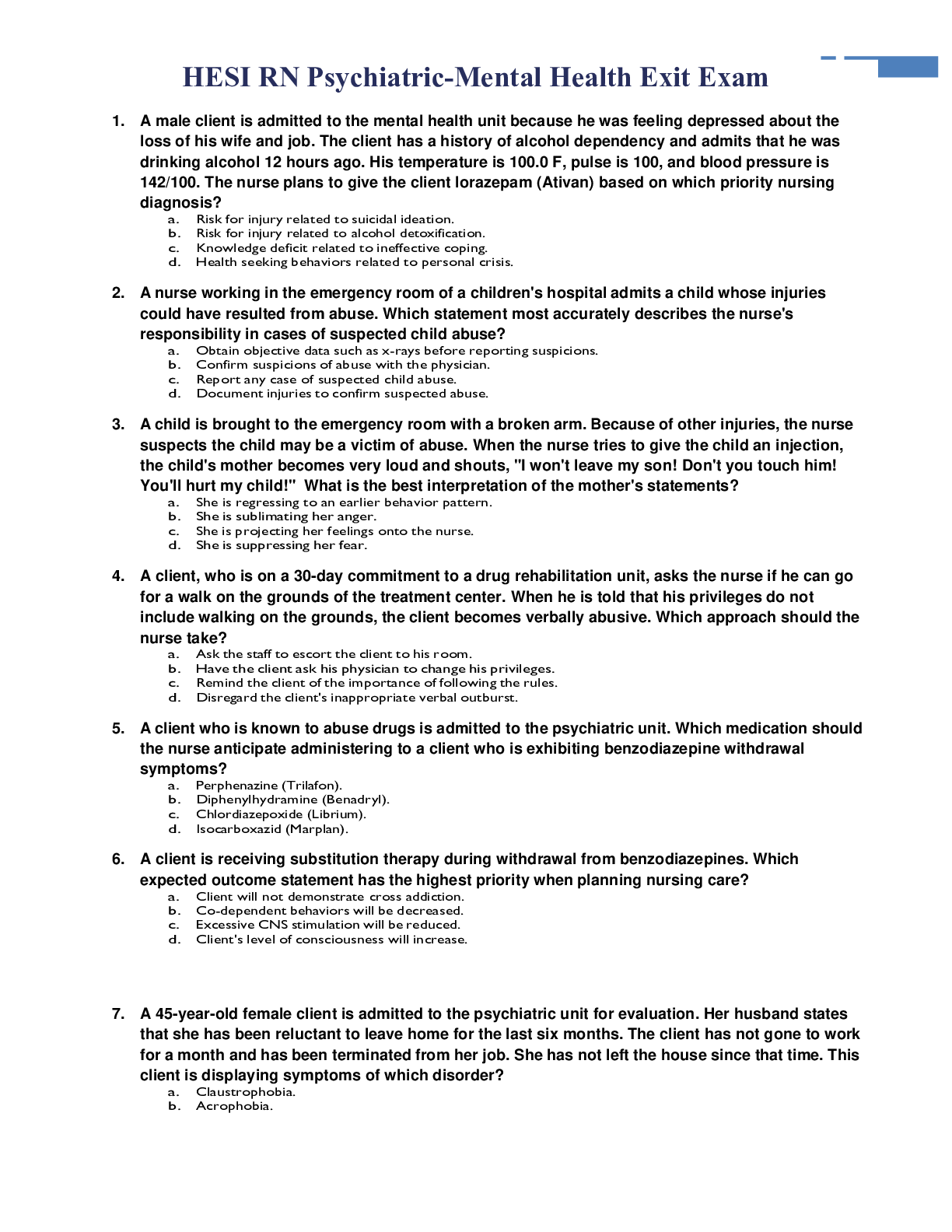
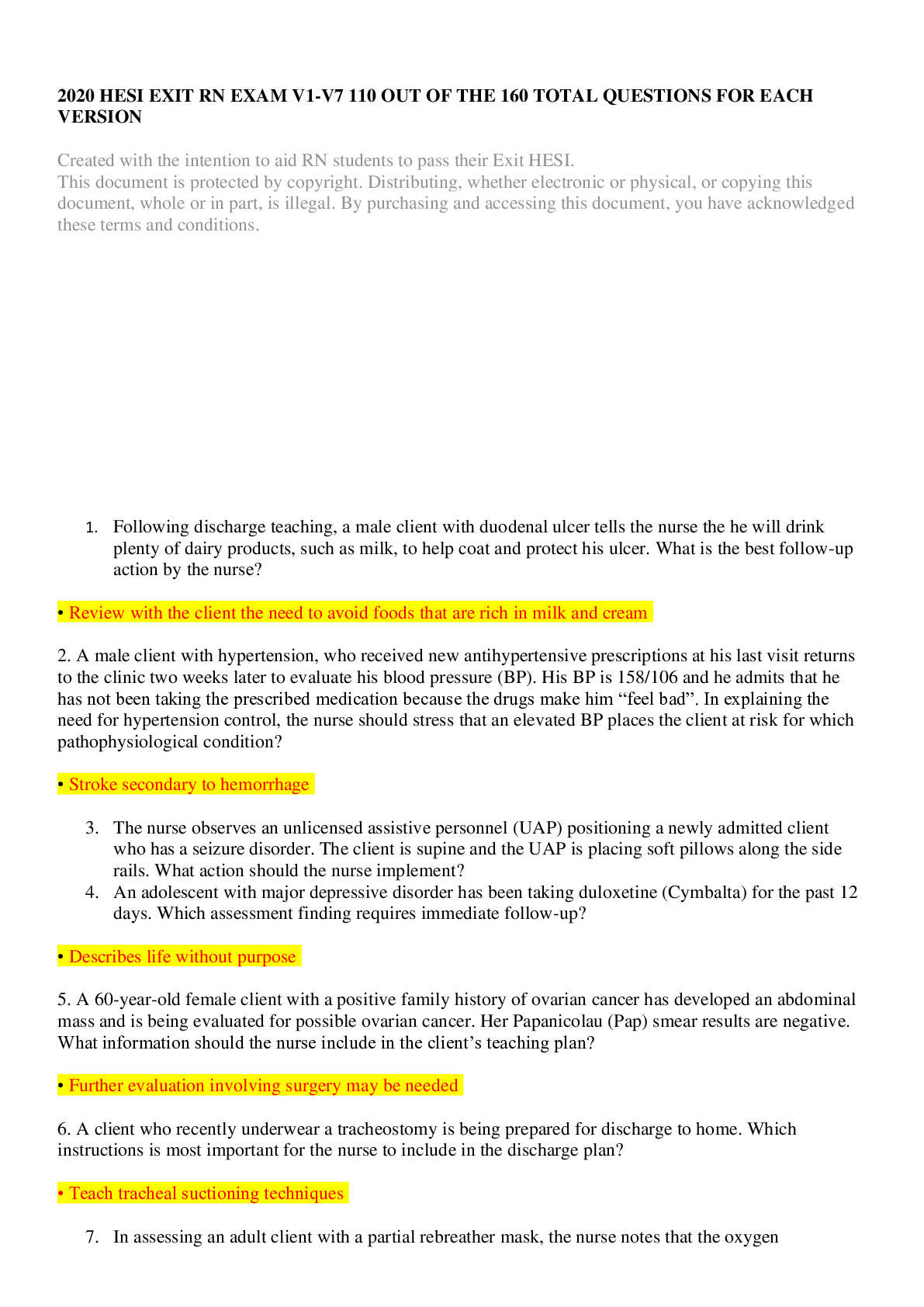


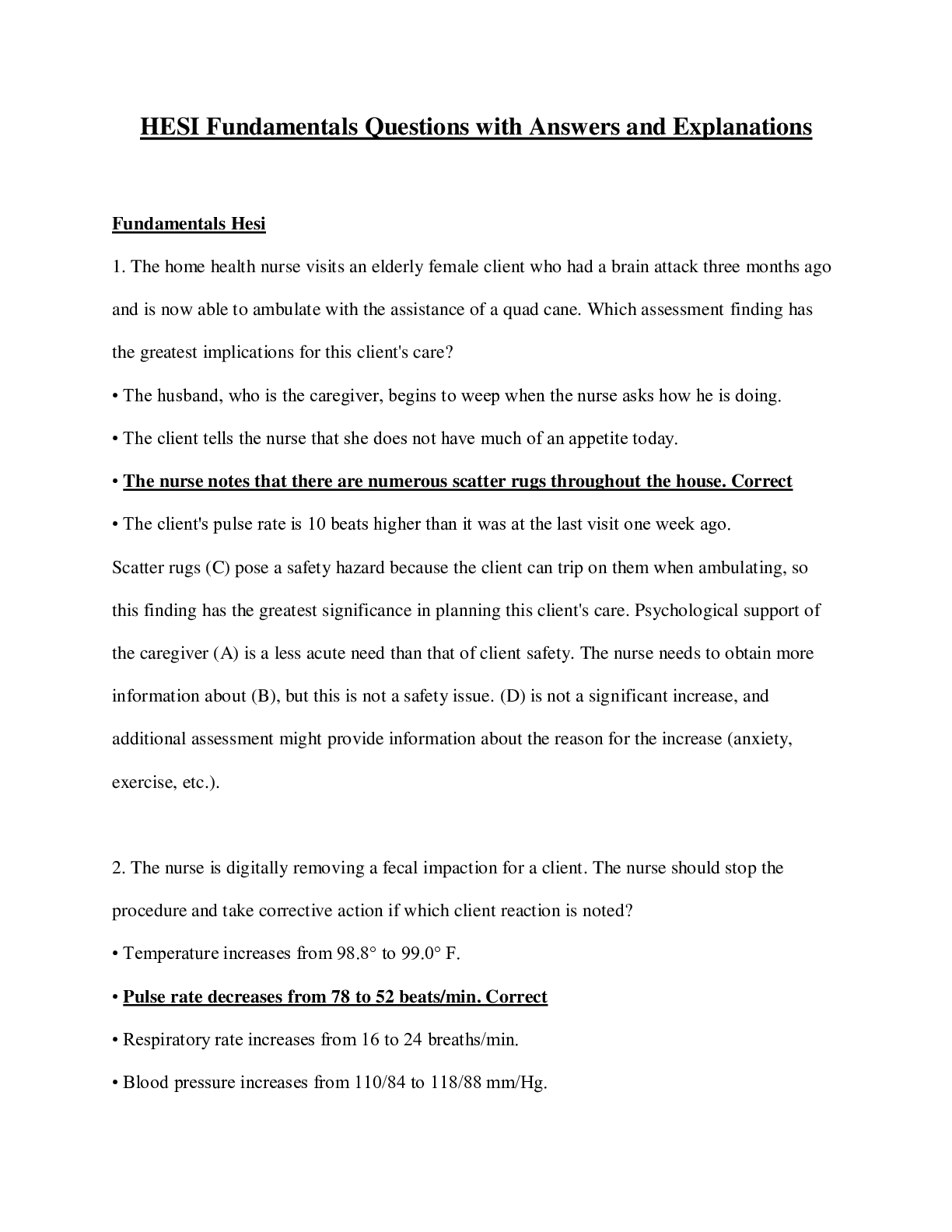

.png)
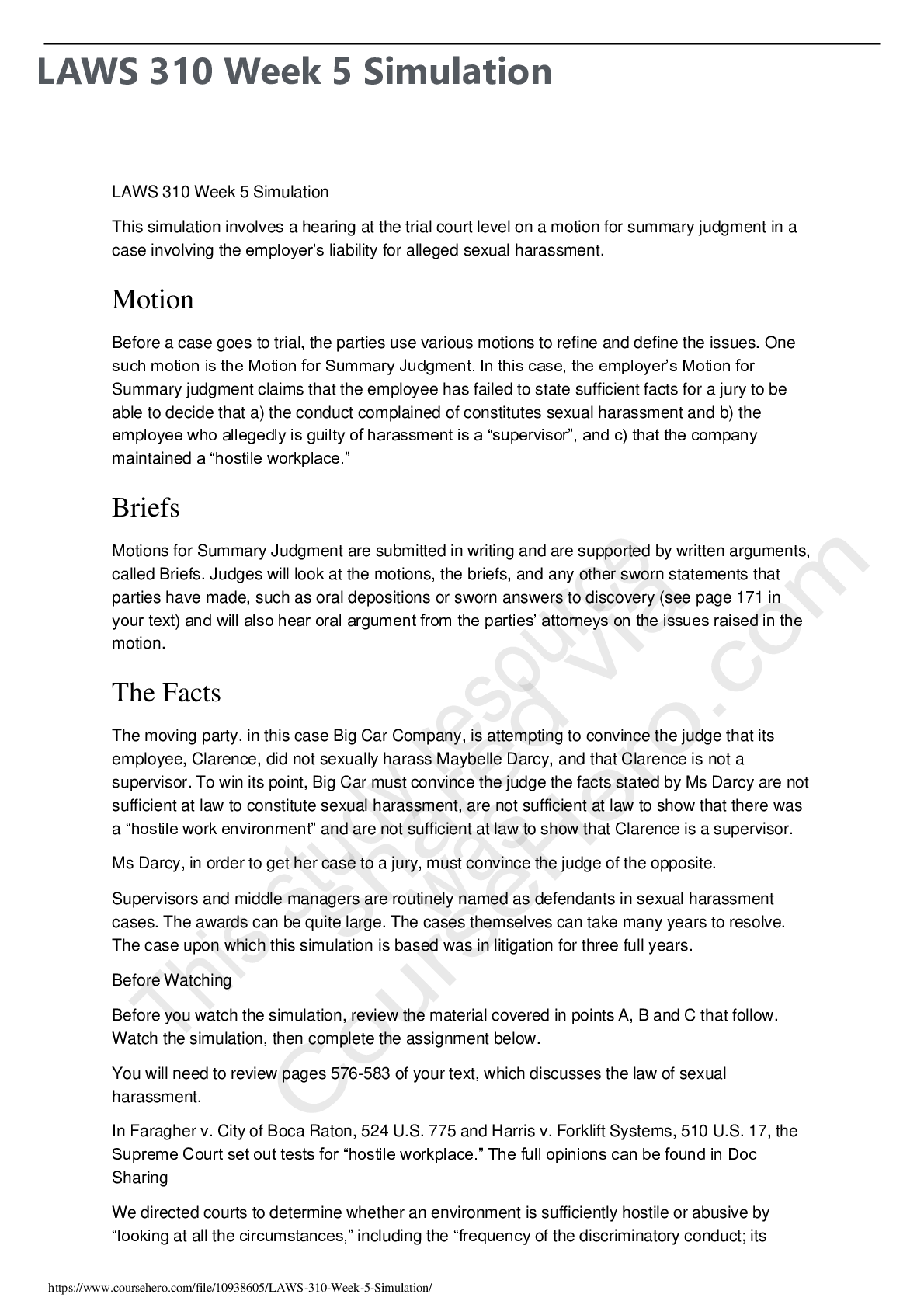
.png)


